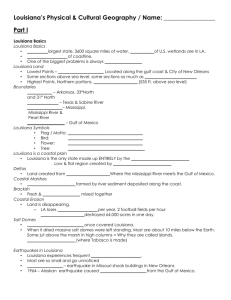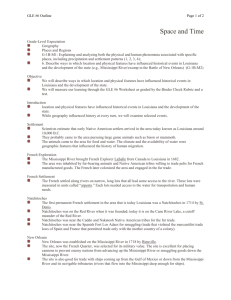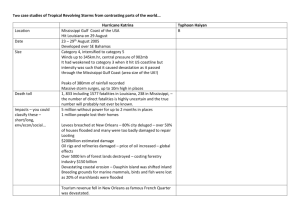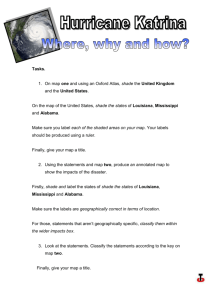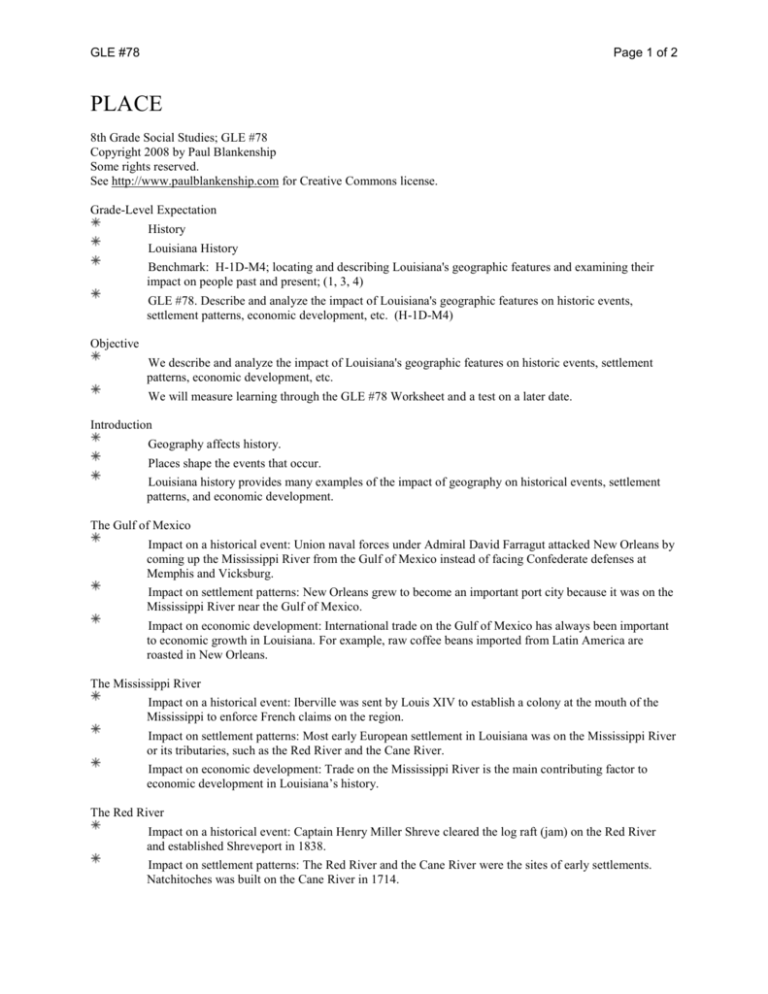
GLE #78
Page 1 of 2
PLACE
8th Grade Social Studies; GLE #78
Copyright 2008 by Paul Blankenship
Some rights reserved.
See http://www.paulblankenship.com for Creative Commons license.
Grade-Level Expectation
History
Louisiana History
Benchmark: H-1D-M4; locating and describing Louisiana's geographic features and examining their
impact on people past and present; (1, 3, 4)
GLE #78. Describe and analyze the impact of Louisiana's geographic features on historic events,
settlement patterns, economic development, etc. (H-1D-M4)
Objective
We describe and analyze the impact of Louisiana's geographic features on historic events, settlement
patterns, economic development, etc.
We will measure learning through the GLE #78 Worksheet and a test on a later date.
Introduction
Geography affects history.
Places shape the events that occur.
Louisiana history provides many examples of the impact of geography on historical events, settlement
patterns, and economic development.
The Gulf of Mexico
Impact on a historical event: Union naval forces under Admiral David Farragut attacked New Orleans by
coming up the Mississippi River from the Gulf of Mexico instead of facing Confederate defenses at
Memphis and Vicksburg.
Impact on settlement patterns: New Orleans grew to become an important port city because it was on the
Mississippi River near the Gulf of Mexico.
Impact on economic development: International trade on the Gulf of Mexico has always been important
to economic growth in Louisiana. For example, raw coffee beans imported from Latin America are
roasted in New Orleans.
The Mississippi River
Impact on a historical event: Iberville was sent by Louis XIV to establish a colony at the mouth of the
Mississippi to enforce French claims on the region.
Impact on settlement patterns: Most early European settlement in Louisiana was on the Mississippi River
or its tributaries, such as the Red River and the Cane River.
Impact on economic development: Trade on the Mississippi River is the main contributing factor to
economic development in Louisiana’s history.
The Red River
Impact on a historical event: Captain Henry Miller Shreve cleared the log raft (jam) on the Red River
and established Shreveport in 1838.
Impact on settlement patterns: The Red River and the Cane River were the sites of early settlements.
Natchitoches was built on the Cane River in 1714.
GLE #78
Page 2 of 2
Impact on economic development: Goods coming from Louisiana and Texas on the Red River
contributed to the economic development of northwest Louisiana.
Coastal Wetlands
Impact on a historical event: The loss of coastal wetlands left New Orleans with less protection from
flood and wind in Hurricane Katrina.
Impact on settlement patterns: Coastal erosion may eventually force many in south Louisiana to relocate
as their land is submerged into the Gulf of Mexico.
Impact on economic development: Coastal erosion may hinder economic development as insurance costs
rise in areas less protected from the full force of hurricanes.
The Sabine River
Impact on a historical event: In 1806 the treacherous American General James Wilkinson (secretly
employed as a Spanish agent) negotiated an agreement with his Spanish counterpart to create a “Neutral
Strip” between the Sabine River and the Arroyo Hondo as a buffer zone to prevent a war between the
United States and Spain. This zone lasted until the Adams-Onís Treaty of 1819 set the boundary of the
United States at the Sabine River.
Impact on settlement patterns: Criminals settled in the Neutral Strip to take advantage of the lack of
government and use it as a staging area for horse-thieving and cattle-rustling.
Impact on economic development: Decent people feared to live in or near this area between 1806 and
1819.
Conclusion
The geography of Louisiana has shaped its history.
Landforms such as waterways and arable lands affect settlement and economic development in
Louisiana.




